第11課-Channel Study For Create Custom Restful Service
这节课我们一起学习利用Mirth Connect的HTTP Listener源通道与JavaScript Writer目的通道搭建自定义Restful风格webapi服务。
1.新建名为‘Custom Restful api’的信道,指定源通道与目的通道的输入输出消息格式

2.设置HTTP Listener类型源通道参数
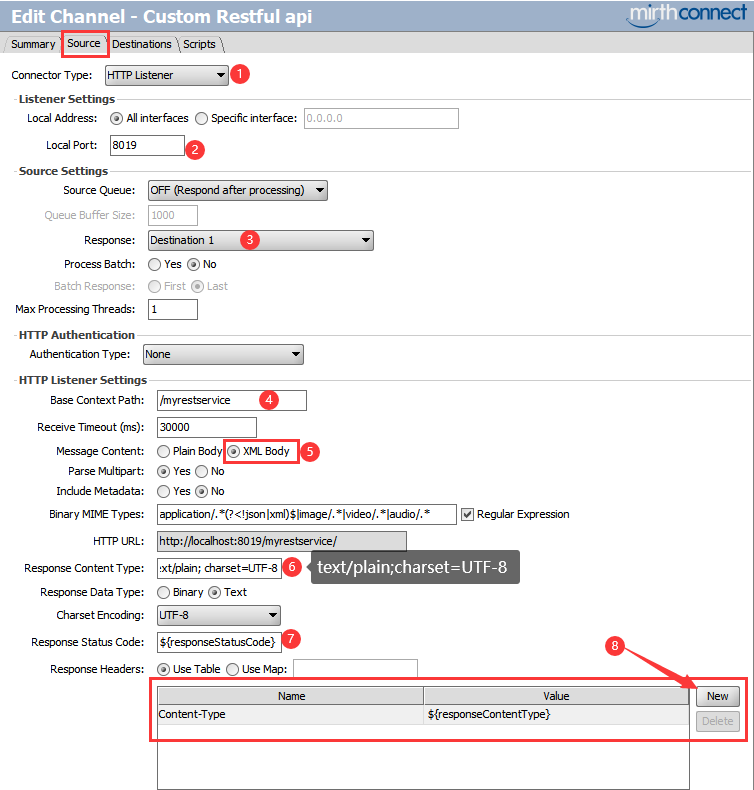
- 把 "Response" 响应指定为 destination 1
- 输入‘Base context path’ 为
/myrestservice - 设置 "Message Content" 为 XML Body
- 设置默认"Response Content Type" 为
text/plain; charset=UTF-8我们将在目的通道中通过channel map重写它的值为application/xml或application/json - 设置 "Response Status Code" 响应码为
${responseStatusCode}我们将在目的通道中通过channel map重写它的值为200(成功)或500(失败) - 在 "Response Header" 中添加一个变量 "Content-Type" ,指定其值为
${responseContentType}我们将在目的通道中通过channel map重写它的值为application/xml或application/json
3.设置JavaScript Writer目的通道参数并编写JS实现脚本
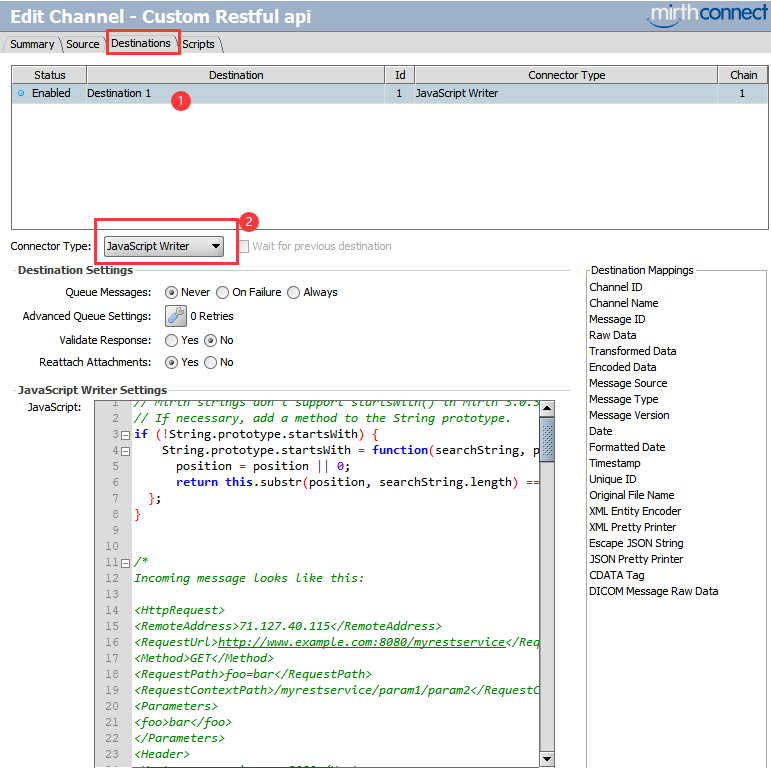
// Mirth strings don't support startsWith() in Mirth 3
// If necessary, add a method to the String prototype.
if (!String.prototype.startsWith) {
String.prototype.startsWith = function(searchString, position){
position = position || 0;
return this.substr(position, searchString.length) === searchString;
};
}
/*
Incoming message looks like this:
<HttpRequest>
<RemoteAddress>71.127.40.115</RemoteAddress>
<RequestUrl>http://www.example.com:8080/myrestservice</RequestUrl>
<Method>GET</Method>
<RequestPath>foo=bar</RequestPath>
<RequestContextPath>/myrestservice/param1/param2</RequestContextPath>
<Parameters>
<foo>bar</foo>
</Parameters>
<Header>
<Host>www.example.com:8080</Host>
<Accept-Encoding>identity</Accept-Encoding>
<User-Agent>Wget/1.18 (darwin15.5.0)</User-Agent>
<Connection>keep-alive</Connection>
<Accept>application/xml</Accept>
</Header>
<Content/>
</HttpRequest>
<HttpRequest>
<RemoteAddress>71.127.40.115</RemoteAddress>
<RequestUrl>http://www.example.com:8080/myrestservice</RequestUrl>
<Method>GET</Method>
<RequestPath>foo=bar</RequestPath>
<RequestContextPath>/myrestservice/param1/param2</RequestContextPath>
<Parameters>
<foo>bar</foo>
</Parameters>
<Header>
<Host>www.example.com:8080</Host>
<Accept-Encoding>identity</Accept-Encoding>
<User-Agent>Wget/1.18 (darwin15.5.0)</User-Agent>
<Connection>keep-alive</Connection>
<Accept>application/json</Accept>
</Header>
<Content/>
</HttpRequest>
*/
// Just in case we fail, set a sane responseContentType
channelMap.put('responseContentType', 'text/plain');
var msg = XML(connectorMessage.getRawData());
logger.info(msg);
// Get the REST data from the "context path" which is actually
// the "path info" of the request, so it will start with '/myrestservice'.
var rest = msg['RequestContextPath'];
logger.info(rest);
var myServicePrefix = '/myrestservice';
var minimumURLParameterCount = 4; // This is the minimum you require to do your work
var maximumExpectedURLParameterCount = 5; // however many you expect to get
var params = rest.substring(myServicePrefix).split('/', maximumExpectedURLParameterCount);
if(params.length < minimumURLParameterCount)
return Packages.com.mirth.connect.server.userutil.ResponseFactory.getErrorResponse('Too few parameters in request');
var mrn = params[1]; // params[0] will be an empty string
logger.info(mrn);
// Now, determine the client's preference for what data type to return (XML vs. JSON).
// We will default to XML.
var clientWantsJSON = false;
var responseContentType = 'text/xml';
// If we see any kind of JSON before any kind of XML, we'll use
// JSON. Otherwise, we'll use XML.
//
// Technically, this is incorrect resolution of the "Accept" header,
// but it's good enough for an example.
var mimeTypes = msg['Header']['Accept'].split(/\s*,\s*/);
for(var i=0; i<mimeTypes.length; ++i) {
var mimeType = mimeTypes[i].toString();
if(mimeType.startsWith('application/json')) {
clientWantsJSON = true;
responseContentType = 'application/json';
break;
} else if(mimeType.startsWith('application/xml')) {
clientWantsJSON = false;
responseContentType = 'application/xml';
break;
} else if(mimeType.startsWith('text/xml')) {
clientWantsJSON = false;
responseContentType = 'text/xml';
break;
}
}
var xml;
var json;
if(clientWantsJSON)
json = { status : '' };
else
xml = new XML('<response></response>');
try {
/*
Here is where you do whatever your service needs to actually do.
*/
if(clientWantsJSON) {
json.data = { foo: 1,
bar: 'a string',
baz: [ 'list', 'of', 'strings']
};
} else {
xml['@foo'] = 1;
xml['bar'] = 'a string';
xml['baz'][0] = 'list';
xml['baz'][1] = 'of';
xml['baz'][3] = 'strings';
}
// Set the response code and content-type appropriately.
// http://www.mirthproject.org/community/forums/showthread.php?t=12678
channelMap.put('responseStatusCode', 200);
if(clientWantsJSON) {
json.status = 'success';
var content = JSON.stringify(json);
channelMap.put('responseContent', content);
channelMap.put('responseContentType', responseContentType);
return content;
} else {
channelMap.put('responseContentType', responseContentType);
var content = xml.toString();
channelMap.put('responseContent', content);
return content;
}
}
catch (err)
{
channelMap.put('responseStatusCode', '500');
if(clientWantsJSON) {
json.status = 'error';
if(err.javaException) {
// If you want to unpack a Java exception, this is how you do it:
json.errorType = String(err.javaException.getClass().getName());
json.errorMessage = String(err.javaException.getMessage());
}
channelMap.put('responseContentType', responseContentType);
// Return an error with our "error" JSON
return Packages.com.mirth.connect.server.userutil.ResponseFactory.getErrorResponse(JSON.stringify(json));
} else {
if(err.javaException) {
xml['response']['error']['@type'] = String(err.javaException.getClass().getName());
xml['response']['error']['@message'] = String(err.javaException.getMessage());
}
channelMap.put('responseContentType', responseContentType);
// Return an error with our "error" XML
return Packages.com.mirth.connect.server.userutil.ResponseFactory.getErrorResponse(xml.toString());
}
}
我们通过目的通道以上JS脚本,学习到以下特别重要的知识:
- 获取输入请求的原始消息并自动格式化为XML格式:
var xml = new XML(connectorMessage.getRawData()) - 设置响应类型,如:
channelMap.put('responseContentType', 'application/json') - 设置响应码,如:
channelMap.put('responseStatusCode', '200') - 设置响应内容并通过JS脚本返回XML实体或者Json实体的字符串格式值
- 异常处理通过JS脚本调用Mirth的API函数Packages.com.mirth.connect.server.userutil.ResponseFactory.getErrorResponse(string)返回字符串格式错误消息
4.部署信道并测试
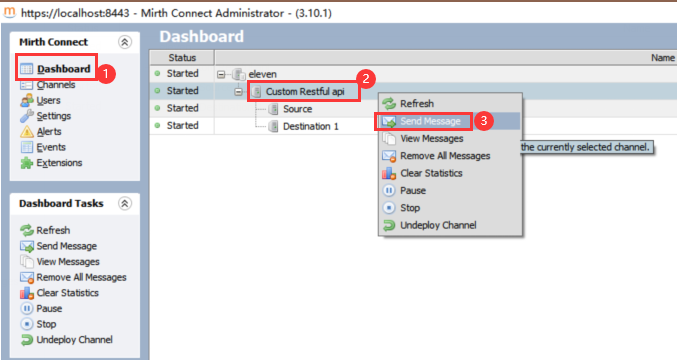
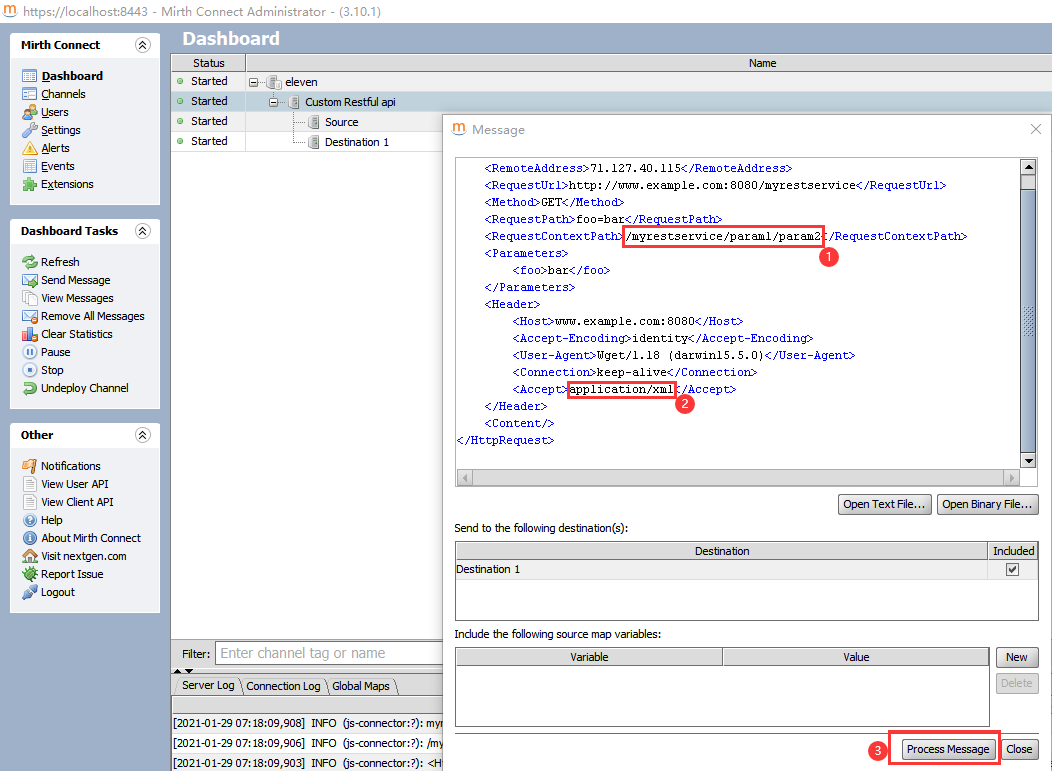
发送消息要区分application/json和application/xml,可以看到响应值格式会相应变化
<HttpRequest>
<RemoteAddress>71.127.40.115</RemoteAddress>
<RequestUrl>http://www.example.com:8080/myrestservice</RequestUrl>
<Method>GET</Method>
<RequestPath>foo=bar</RequestPath>
<RequestContextPath>/myrestservice/param1/param2</RequestContextPath>
<Parameters>
<foo>bar</foo>
</Parameters>
<Header>
<Host>www.example.com:8080</Host>
<Accept-Encoding>identity</Accept-Encoding>
<User-Agent>Wget/1.18 (darwin15.5.0)</User-Agent>
<Connection>keep-alive</Connection>
<Accept>application/json</Accept>
</Header>
<Content/>
</HttpRequest>
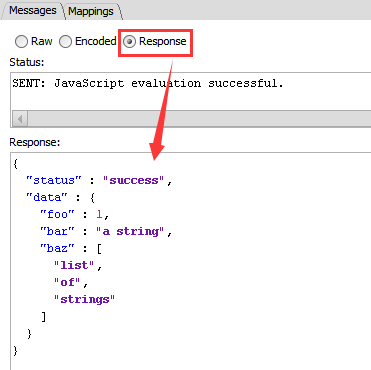
<HttpRequest>
<RemoteAddress>71.127.40.115</RemoteAddress>
<RequestUrl>http://www.example.com:8080/myrestservice</RequestUrl>
<Method>GET</Method>
<RequestPath>foo=bar</RequestPath>
<RequestContextPath>/myrestservice/param1/param2</RequestContextPath>
<Parameters>
<foo>bar</foo>
</Parameters>
<Header>
<Host>www.example.com:8080</Host>
<Accept-Encoding>identity</Accept-Encoding>
<User-Agent>Wget/1.18 (darwin15.5.0)</User-Agent>
<Connection>keep-alive</Connection>
<Accept>application/xml</Accept>
</Header>
<Content/>
</HttpRequest>
潤沁網路大學





 浙公网安备 33010602011771号
浙公网安备 33010602011771号